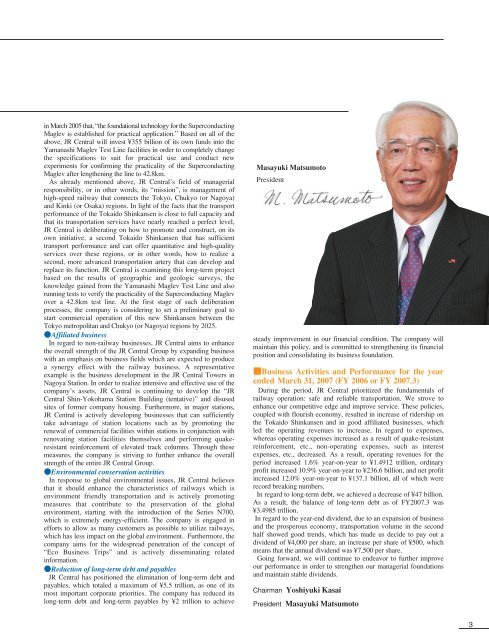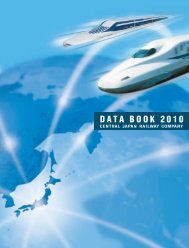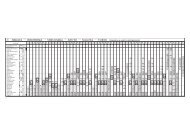CENTRAL JAPAN RAILWAY COMPANY Annual Report 2007
CENTRAL JAPAN RAILWAY COMPANY Annual Report 2007
CENTRAL JAPAN RAILWAY COMPANY Annual Report 2007
Create successful ePaper yourself
Turn your PDF publications into a flip-book with our unique Google optimized e-Paper software.
in March 2005 that, “the foundational technology for the Superconducting<br />
Maglev is established for practical application.” Based on all of the<br />
above, JR Central will invest ¥355 billion of its own funds into the<br />
Yamanashi Maglev Test Line facilities in order to completely change<br />
the specifications to suit for practical use and conduct new<br />
experiments for confirming the practicality of the Superconducting<br />
Maglev after lengthening the line to 42.8km.<br />
As already mentioned above, JR Central’s field of managerial<br />
responsibility, or in other words, its “mission”, is management of<br />
high-speed railway that connects the Tokyo, Chukyo (or Nagoya)<br />
and Kinki (or Osaka) regions. In light of the facts that the transport<br />
performance of the Tokaido Shinkansen is close to full capacity and<br />
that its transportation services have nearly reached a perfect level,<br />
JR Central is deliberating on how to promote and construct, on its<br />
own initiative, a second Tokaido Shinkansen that has sufficient<br />
transport performance and can offer quantitative and high-quality<br />
services over these regions, or in other words, how to realize a<br />
second, more advanced transportation artery that can develop and<br />
replace its function. JR Central is examining this long-term project<br />
based on the results of geographic and geologic surveys, the<br />
knowledge gained from the Yamanashi Maglev Test Line and also<br />
running tests to verify the practicality of the Superconducting Maglev<br />
over a 42.8km test line. At the first stage of such deliberation<br />
processes, the company is considering to set a preliminary goal to<br />
start commercial operation of this new Shinkansen between the<br />
Tokyo metropolitan and Chukyo (or Nagoya) regions by 2025.<br />
Affiliated business<br />
In regard to non-railway businesses, JR Central aims to enhance<br />
the overall strength of the JR Central Group by expanding business<br />
with an emphasis on business fields which are expected to produce<br />
a synergy effect with the railway business. A representative<br />
example is the business development in the JR Central Towers in<br />
Nagoya Station. In order to realize intensive and effective use of the<br />
company’s assets, JR Central is continuing to develop the “JR<br />
Central Shin-Yokohama Station Building (tentative)” and disused<br />
sites of former company housing. Furthermore, in major stations,<br />
JR Central is actively developing businesses that can sufficiently<br />
take advantage of station locations such as by promoting the<br />
renewal of commercial facilities within stations in conjunction with<br />
renovating station facilities themselves and performing quakeresistant<br />
reinforcement of elevated track columns. Through these<br />
measures, the company is striving to further enhance the overall<br />
strength of the entire JR Central Group.<br />
Environmental conservation activities<br />
In response to global environmental issues, JR Central believes<br />
that it should enhance the characteristics of railways which is<br />
environment friendly transportation and is actively promoting<br />
measures that contribute to the preservation of the global<br />
environment, starting with the introduction of the Series N700,<br />
which is extremely energy-efficient. The company is engaged in<br />
efforts to allow as many customers as possible to utilize railways,<br />
which has less impact on the global environment. Furthermore, the<br />
company aims for the widespread penetration of the concept of<br />
“Eco Business Trips” and is actively disseminating related<br />
information.<br />
Reduction of long-term debt and payables<br />
JR Central has positioned the elimination of long-term debt and<br />
payables, which totaled a maximum of ¥5.5 trillion, as one of its<br />
most important corporate priorities. The company has reduced its<br />
long-term debt and long-term payables by ¥2 trillion to achieve<br />
Masayuki Matsumoto<br />
President<br />
steady improvement in our financial condition. The company will<br />
maintain this policy, and is committed to strengthening its financial<br />
position and consolidating its business foundation.<br />
Business Activities and Performance for the year<br />
ended March 31, <strong>2007</strong> (FY 2006 or FY <strong>2007</strong>.3)<br />
During the period, JR Central prioritized the fundamentals of<br />
railway operation: safe and reliable transportation. We strove to<br />
enhance our competitive edge and improve service. These policies,<br />
coupled with flourish economy, resulted in increase of ridership on<br />
the Tokaido Shinkansen and in good affiliated businesses, which<br />
led the operating revenues to increase. In regard to expenses,<br />
whereas operating expenses increased as a result of quake-resistant<br />
reinforcement, etc., non-operating expenses, such as interest<br />
expenses, etc., decreased. As a result, operating revenues for the<br />
period increased 1.6% year-on-year to ¥1.4912 trillion, ordinary<br />
profit increased 10.9% year-on-year to ¥236.6 billion, and net profit<br />
increased 12.0% year-on-year to ¥137.1 billion, all of which were<br />
record breaking numbers.<br />
In regard to long-term debt, we achieved a decrease of ¥47 billion.<br />
As a result, the balance of long-term debt as of FY<strong>2007</strong>.3 was<br />
¥3.4985 trillion.<br />
In regard to the year-end dividend, due to an expansion of business<br />
and the prosperous economy, transportation volume in the second<br />
half showed good trends, which has made us decide to pay out a<br />
dividend of ¥4,000 per share, an increase per share of ¥500, which<br />
means that the annual dividend was ¥7,500 per share.<br />
Going forward, we will continue to endeavor to further improve<br />
our performance in order to strengthen our managerial foundations<br />
and maintain stable dividends.<br />
Chairman Yoshiyuki Kasai<br />
President Masayuki Matsumoto<br />
3





